本文介绍了线上业务中的一些异步调用实践经验,包含 IO 模型介绍、CompletableFuture 的基本使用、RPC 异步调用、异步 HTTP 客户端 Spring WebClient 的使用等。RPC 使用前文介绍的手写 RPC 框架,该框架支持异步调用。
本文要点:
为什么需要异步调用CompletableFuture 基本使用RPC 异步调用HTTP 异步调用编排 CompletableFuture 提高吞吐量首先我们先回顾一下 BIO 模型:
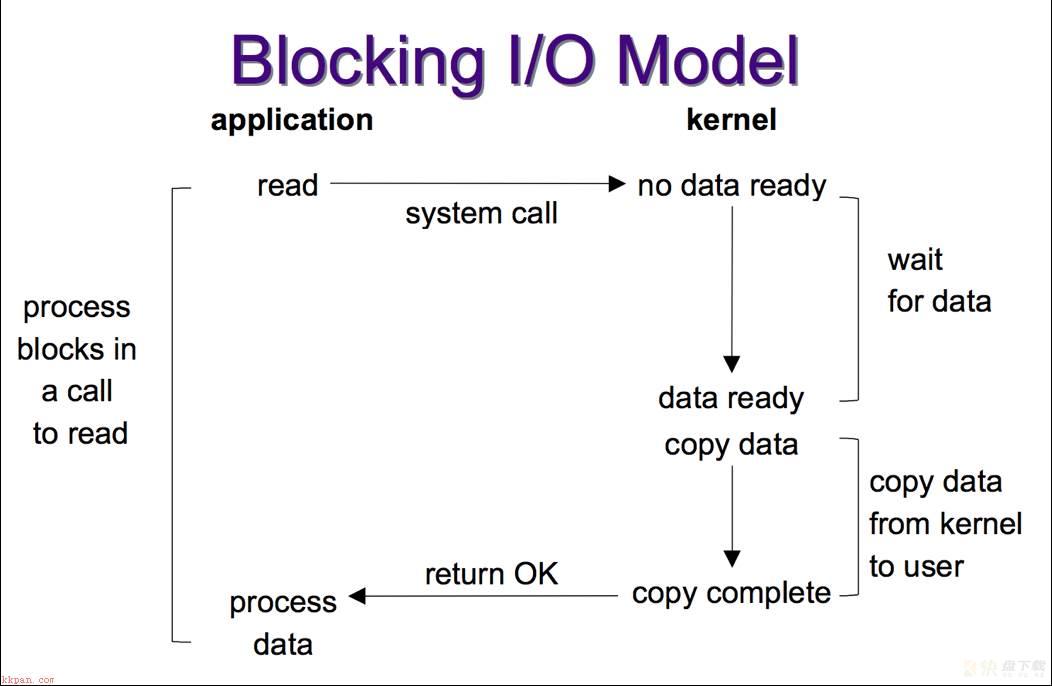
当用户进程调用了recvfrom 这个系统调用,kernel 就开始了 IO 的第一个阶段:准备数据。对于 network io 来说,很多时候数据在一开始还没有到达(比如,还没有收到一个完整的UDP包),这个时候 kernel 就要等待足够的数据到来。而在用户进程这边,整个进程会被阻塞。当 kernel 一直等到数据准备好了,它就会将数据从 kernel 中拷贝到用户内存,然后 kernel 返回结果,用户进程才解除 block 的状态,重新运行起来。所以,Blocking IO 的特点就是在 IO 执行的两个阶段都被 block 了。
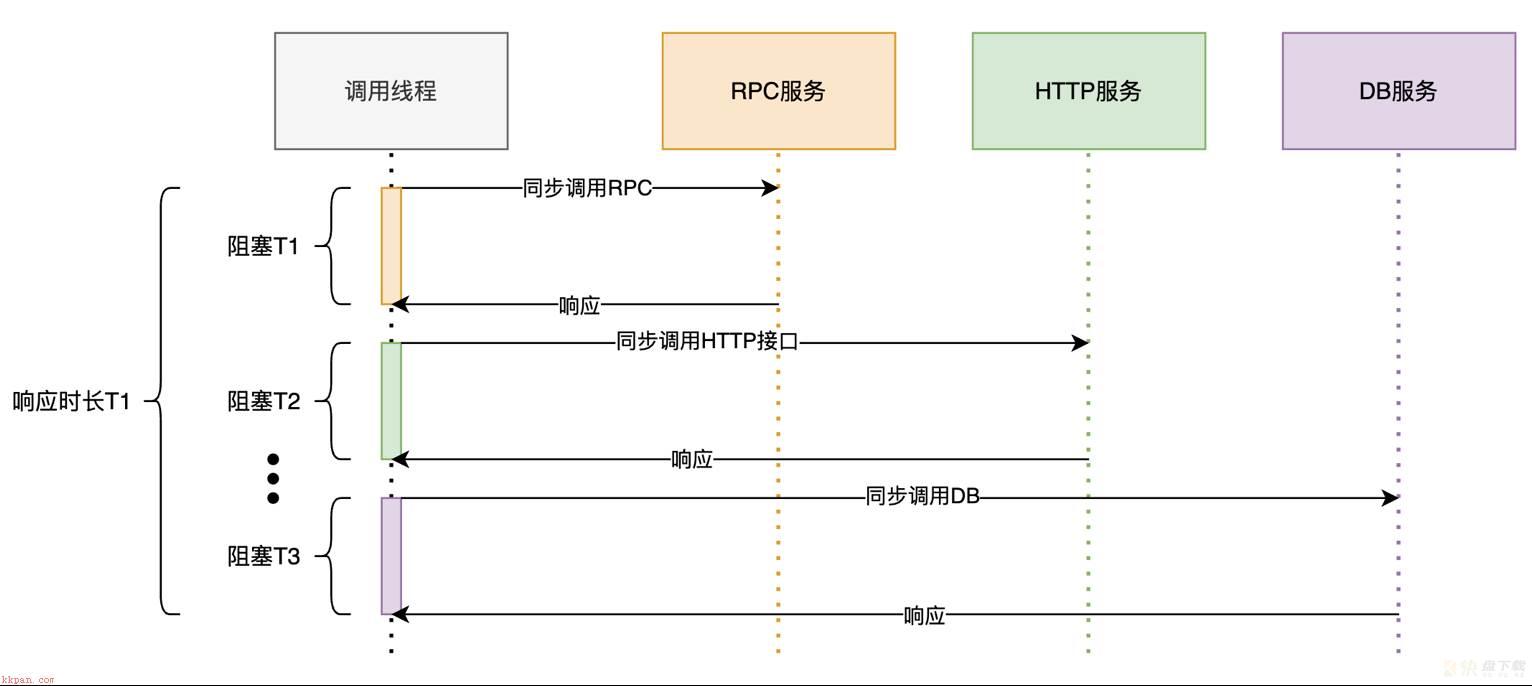
在同步调用的场景下,依次请求多个接口,耗时长、性能差,接口响应时长 T > T1+T2+T3+……+Tn。
一般这个时候为了减少同步等待时间,会使用线程池来同时处理多个任务,接口的响应时间就是 MAX(T1,T2,T3):
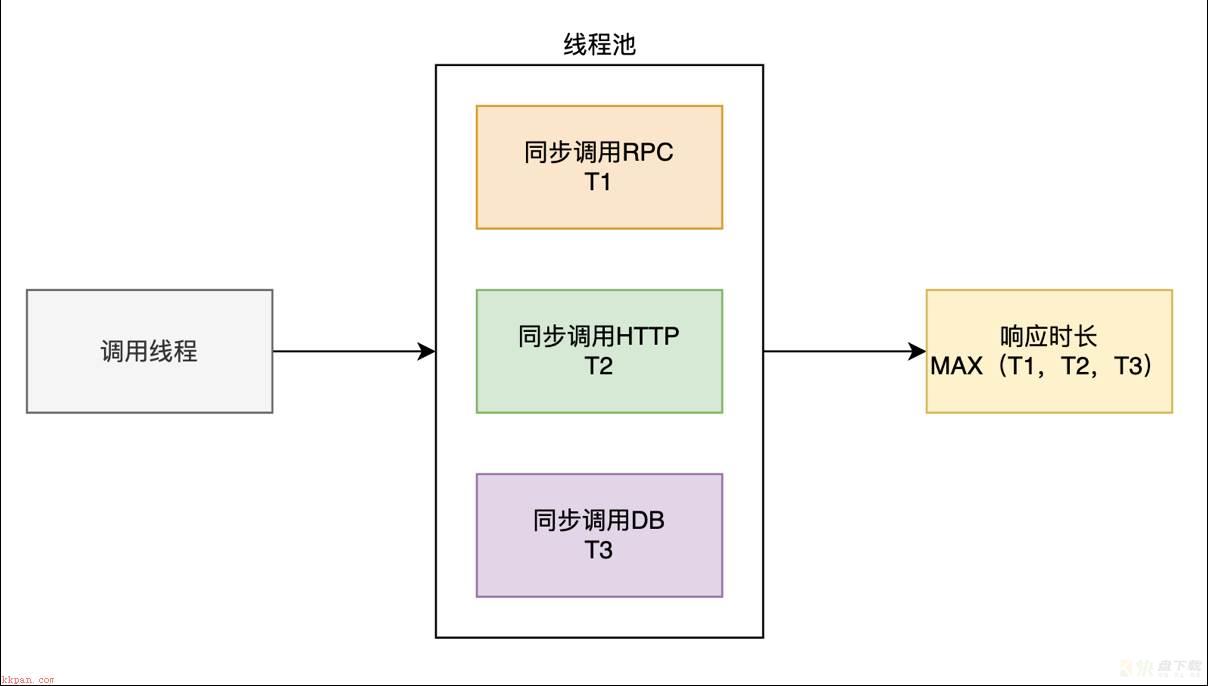
大概代码如下:
Future<String> future = executorService.submit(() -> {
Thread.sleep(2000);
return "hello world";
});
while (true) {
if (future.isDone()) {
System.out.println(future.get());
break;
}
}同步模型中使用线程池确实能实现异步调用的效果,也能压缩同步等待的时间,但是也有一些缺陷:
CPU 资源大量浪费在阻塞等待上,导致 CPU 资源利用率低。为了增加并发度,会引入更多额外的线程池,随着 CPU 调度线程数的增加,会导致更严重的资源争用,上下文切换占用 CPU 资源。线程池中的线程都是阻塞的,硬件资源无法充分利用,系统吞吐量容易达到瓶颈。为了解决 BIO 中的缺陷,引入 NIO 模型:
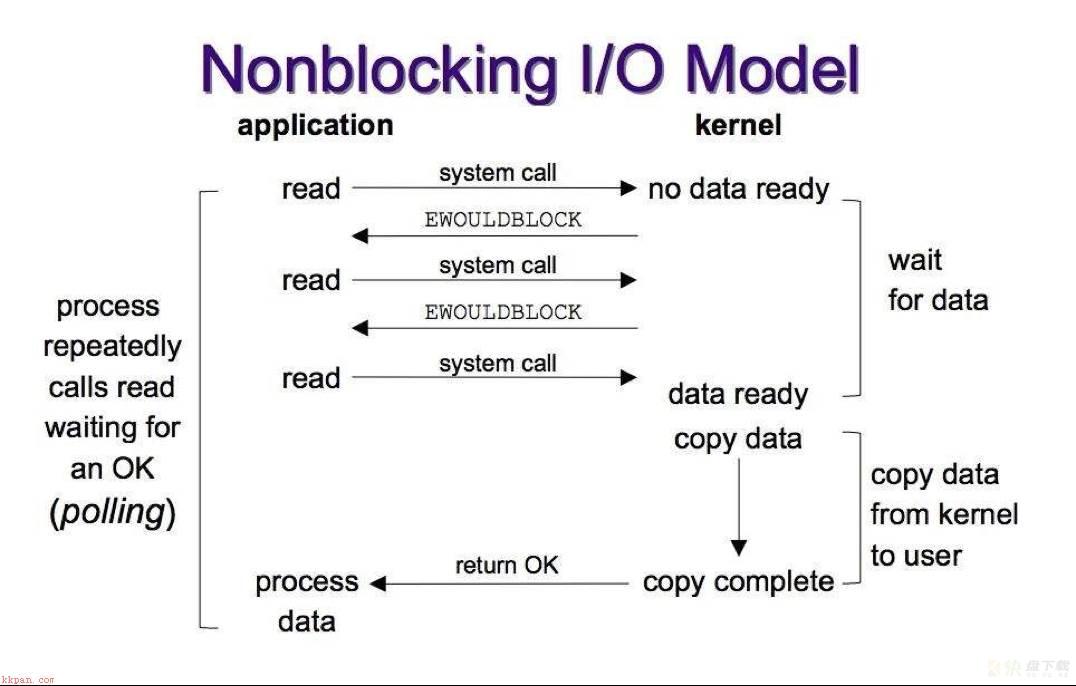
当用户进程发出 read 操作时,如果 kernel 中的数据还没有准备好,那么它并不会 block 用户进程,而是立刻返回一个 error。从用户进程角度讲 ,它发起一个 read 操作后,并不需要等待,而是马上就得到了一个结果。用户进程判断结果是一个 error 时,它就知道数据还没有准备好,于是它可以再次发送 read 操作。一旦 kernel 中的数据准备好了,并且又再次收到了用户进程的 system call,那么它马上就将数据拷贝到了用户内存,然后返回。所以,用户进程其实是需要不断的主动询问 kernel 数据好了没有。
我们知道了 NIO 的调用方式比 BIO 好,那我们怎么能在业务编码中使用到 NIO 呢?自己动手将 BIO 替换成 NIO 肯定不现实,已有组件支持 NIO 的可以直接使用,不支持的继续使用自定义线程池。
通过 RPC NIO 异步调用、 HTTP 异步调用的方式降低线程数,从而降低调度(上下文切换)开销。没有原生支持 NIO 异步调用的继续使用线程池。引入 CompletableFuture 对业务流程进行编排,降低依赖之间的阻塞。CompletableFuture 是 java.util.concurrent 库在 java 8 中新增的主要工具,同传统的 Future 相比,其支持流式计算、函数式编程、完成通知、自定义异常处理等很多新的特性。
CompletableFuture<String> future = CompletableFuture.supplyAsync(()->{
try{
Thread.sleep(1000L);
return "hello world";
} catch (Exception e){
return "failed";
}
});
System.out.println(future.join());
// output
hello world开启异步任务,到另一个线程执行。
CompletableFuture<String> future1 = new CompletableFuture<>();
future.complete("hello world"); //异步线程执行
future.whenComplete((res, throwable) -> {
System.out.println(res);
});
System.out.println(future1.join());
CompletableFuture<String> future2 = new CompletableFuture<>();
future.completeExceptionally(new Throwable("failed")); //异步线程执行
System.out.println(future2.join());
// output
hello world
hello world
Exception in thread "main"
java.util.concurrent.CompletionException:
java.lang.Throwable: failedcomplete 正常完成该 CompletableFuture。
completeExceptionally 异常完成该 CompletableFuture。
String original = "Message";
CompletableFuture<String> cf =
CompletableFuture.completedFuture(original).thenApply(String::toUpperCase);
System.out.println(cf.join());
// output
MESSAGE任务后置处理。
图示:

CompletableFuture<String> cf =
CompletableFuture.completedFuture("Message").thenApply(String::toUpperCase);
CompletableFuture<String> cf1 =
CompletableFuture.completedFuture("Message").thenApply(String::toLowerCase);
CompletableFuture<String> allCf = cf.thenCombine(cf1, (s1, s2) -> s1 + s2);
System.out.println(allCf.join());
// output
MSGmsg合并任务,两个任务同时执行,结果由合并函数 BiFunction 返回。
图示:
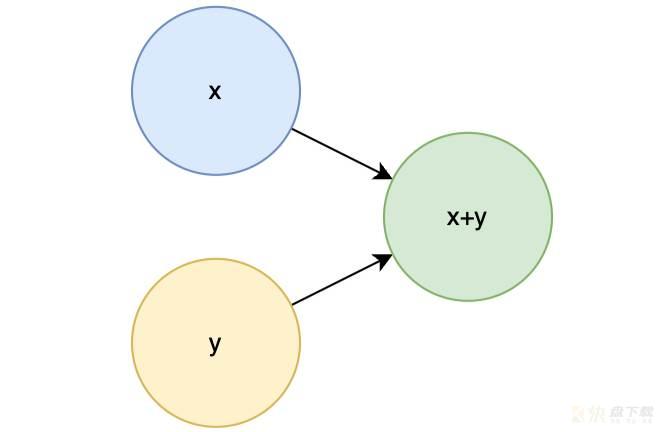
CompletableFuture<String> future1 = CompletableFuture.supplyAsync(() -> "Message1");
CompletableFuture<String> future2 = CompletableFuture.supplyAsync(() -> "Message2");
CompletableFuture<String> future3 = CompletableFuture.supplyAsync(() -> "Message3");
CompletableFuture<String> future =
CompletableFuture.allOf(future1, future2, future3).thenApply(v -> {
String join1 = future1.join();
String join2 = future2.join();
String join3 = future3.join();
return join1 + join2 + join3;});
System.out.println(future.join());
// output
Msg1Msg2Msg3allOf 会阻塞等待所有异步线程任务结束。
allOf 里的 join 并不会阻塞,传给 thenApply 的函数是在 future1, future2, future3 全部完成时,才会执行 。
图示:
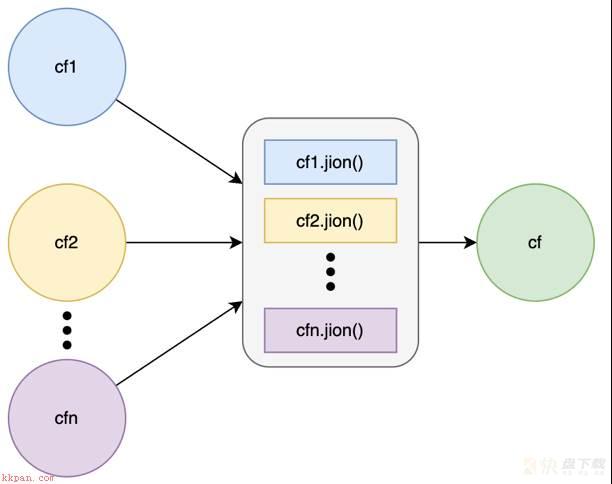
下面有两个小demo,可以先试着想想输出的结果:
String original = "Message";
CompletableFuture cf = CompletableFuture.supplyAsync(() -> {
System.out.println("supplyAsync thread: " + Thread.currentThread().getName());
return original;
}).thenApply(r -> {
System.out.println("thenApply thread: " + Thread.currentThread().getName());
return r;
});
System.out.println(cf.join());
// output
supplyAsync thread: ForkJoinPool.commonPool-worker-1
thenApply thread: main
MessageString original = "Message";
CompletableFuture cf = CompletableFuture.supplyAsync(() -> {
System.out.println("supplyAsync thread: " + Thread.currentThread().getName());
try {
Thread.sleep(100);
} catch (InterruptedException e) {
throw new RuntimeException(e);
}
return original;
}).thenApply(r -> {
System.out.println("thenApply thread: " + Thread.currentThread().getName());
return r;
});
System.out.println(cf.join());
// output
supplyAsync thread: ForkJoinPool.commonPool-worker-1
thenApply thread: ForkJoinPool.commonPool-worker-1
Message先看结论:
执行 complete 的线程会执行当前调用链上的所有CF。如果 CF 提前 complete,后续 CF 由初始线程执行。异步任务里没有 sleep 的时候,异步任务很快就会完成,意味着 JVM 执行到 thenApply 的时候,前置 CF 已经提前完成所以后续的 CF 会被 main 线程执行。
异步任务里有 sleep 的时候, JVM 执行到 thenApply 时,前置 CF 还没有完成,前置 CF complete 的线程会执行所有后续的 CF。
ExecutorService executorService = Executors.newFixedThreadPool(2);
CompletableFuture<Integer> cf1 = CompletableFuture.supplyAsync(() -> {
Thread.sleep(3000);
return 1;
}, executorService);
CompletableFuture<Integer> cf2 = CompletableFuture.supplyAsync(() -> {
Thread.sleep(3000);
return 2;
}, executorService);
Integer join1 = cf1.thenApply((cf1Val) -> {
System.out.println("cf1 start value:" + cf1Val);
Integer cf2Val = cf2.join();
System.out.println("cf2 end value:" + cf2Val);
return 3;
}).join();
//output
cf1 start value:1
cf2 end value:2代码很简单,有一个线程数为 2 的线程池,cf1、cf2 都使用这个线程执行异步任务,特别的是在 cf1.thenApply 中会调用 cf2.join(),当线程数是2的时候可以顺利输出。
ExecutorService executorService = Executors.newFixedThreadPool(1);
CompletableFuture<Integer> cf1 = CompletableFuture.supplyAsync(() -> {
Thread.sleep(3000);
return 1;
}, executorService);
CompletableFuture<Integer> cf2 = CompletableFuture.supplyAsync(() -> {
Thread.sleep(3000);
return 2;
}, executorService);
Integer join1 = cf1.thenApply((cf1Val) -> {
System.out.println("cf1 start value:" + cf1Val);
Integer cf2Val = cf2.join();
System.out.println("cf2 end value:" + cf2Val);
return 3;
}).join();
//output
cf1 start value:1这时候我们将线程池的线程数调整为 1,这时只会输出 cf1 start value:1,然后就一直阻塞。
使用 jstack -l pid 查看线程状态,发现是 WAITING,等待的地方正是我们在代码里调用的cf2.join():
"pool-1-thread-1" #11 prio=5 os_prio=31 tid=0x00000001429f5000 nid=0xa903 waiting on condition
java.lang.Thread.State: WAITING (parking)
at sun.misc.Unsafe.park(Native Method)
- parking to wait for <0x000000076ba5f7d0> (a java.util.concurrent.CompletableFuture$Signaller)
at java.util.concurrent.locks.LockSupport.park(LockSupport.java:175)
at java.util.concurrent.CompletableFuture$Signaller.block(CompletableFuture.java:1707)
at java.util.concurrent.ForkJoinPool.managedBlock(ForkJoinPool.java:3323)
at java.util.concurrent.CompletableFuture.waitingGet(CompletableFuture.java:1742)
at java.util.concurrent.CompletableFuture.join(CompletableFuture.java:1947)
at com.ppphuang.demo.threadPool.ExecutorsTest.lambda$main$2(ThreadPoolExecutorsTest.java:34)原因是我们在唯一一个线程中调用 cf2.join(),阻塞等待 cf2 完成,但是 cf2 需要等待 cf1 完成之后才有空闲线程去执行。这就类似于你右手正拿着一个水杯,然后等待右手拿水壶倒满水,这是不可能完成的。所以尽量不要嵌套join,不注意隔离线程池的话很容易造成’死锁‘(线程阻塞)。
API
描述
supplyAsync
开启异步任务,到另一个线程执行,异步任务有返回值。
complete
完成任务。
completeExceptionally
异常结束任务。
thenCombine
合并任务,两个任务同时执行,结果由合并函数 BiFunction 返回。
thenApply
任务后置处理。
applyToEither
会取两个任务最先完成的任务,上个任务和这个任务同时进行,哪个先结束,先用哪个结果。
handle
后续处理。
whenComplete
完成后的处理。
allOf
等待所有异步线程任务结束。
join
获取返回值,没有complete的 CF 对象调用join时,会等待complete再返回,已经 complete的 CF 对象调用join时,会立刻返回结果。
我们手写的这个 RPC 框架支持异步调用,如果你想看具体的实现,可以在文末找到源码链接。异步调用之前会设置一个 CallBack 方法,异步调用时会直接返回 null,不会等待服务端返回接果,服务端返回结果之后会通过 RPC 客户端自带的线程池执行设置的 CallBack 方法。
RPC 异步调用图示:
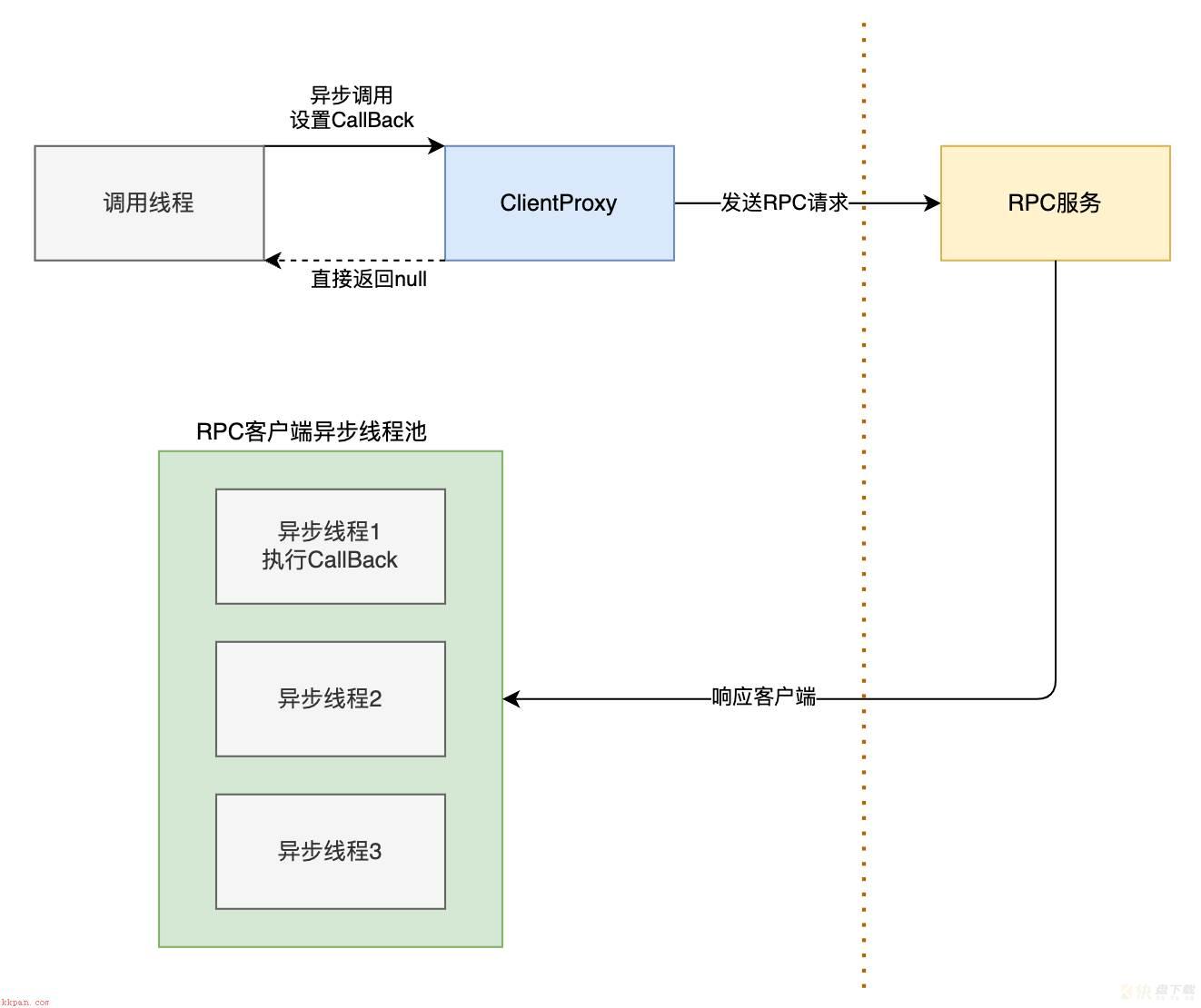
通过 AsyncExecutor 包装 RPC的客户端,AsyncExecutor 类中的 client 属性值为创建的某个 RPC 服务的异步客户端代理类,这个代理类在构造方法中创建并赋值给 client 属性。
类中的 async 方法接受 Function 类型的参数 function,可以通过 function.apply(client) 来通过 client 执行真正的 RPC 调用。
在 async 方法中实例化一个 CompletableFuture, 并将 CompletableFuture 作为异步回调的上下文设置到 RPC 的异步回调中,之后将该 CompletableFuture 返回给调用者。
public class AsyncExecutor<C> {
private C client;
public AsyncExecutor(ClientProxyFactory clientProxyFactory, Class<C> clazz, String group, String version) {
this.client = clientProxyFactory.getProxy(clazz, group, version, true);
}
public <R> CompletableFuture<R> async(Function<C, R> function) {
CompletableFuture<R> future = new CompletableFuture<>();
ClientProxyFactory.setLocalAsyncContextAndAsyncReceiveHandler(future, CompletableFutureAsyncCallBack.instance());
try {
function.apply(client);
} catch (Exception e) {
future.completeExceptionally(e);
}
return future;
}
}public class CompletableFutureAsyncCallBack extends AsyncReceiveHandler {
private static volatile CompletableFutureAsyncCallBack INSTANCE;
private CompletableFutureAsyncCallBack() {
}
@Override
public void callBack(Object context, Object result) {
if (!(context instanceof CompletableFuture)) {
throw new IllegalStateException("the context must be CompletableFuture");
}
CompletableFuture future = (CompletableFuture) context;
if (result instanceof Throwable) {
future.completeExceptionally((Throwable) result);
return;
}
log.info("result:{}", result);
future.complete(result);
}
}AsyncReceiveHandler 是 RPC 的异步回调抽象类,类中的 callBack、onException 抽象方法需要子类实现。
CompletableFutureAsyncCallBack 实现了这个 callBack 抽象方法,第一个参数是我们在包装异步 RPC Client 时设置的 CompletableFuture 上下文,第二个参数是 RPC 返回的结果。方法中判断 RPC 返回的结果是否异常,若异常通过 completeExceptionally 异常结束这个 CompletableFuture,若正常通过 complete 正常结束这个 CompletableFuture。
@Component
public class AsyncExecutorConfig {
@Autowired
ClientProxyFactory clientProxyFactory;
@Bean
public AsyncExecutor<DemoService> demoServiceAsyncExecutor() {
return new AsyncExecutor<>(clientProxyFactory, DemoService.class, "", "");
}
}@Autowired
AsyncExecutor<DemoService> demoServiceAsyncExecutor;
CompletableFuture<String> pppName = demoServiceAsyncExecutor.async(service -> service.hello("ppp"));
String name = pppName.join();WebClient 是从 Spring WebFlux 5.0 版本开始提供的一个非阻塞的基于响应式编程的进行 HTTP 请求的客户端工具。它的响应式编程的基于 Reactor 的。
WebClient的优势在于:
非阻塞响应式 IO,单位时间内有限资源下支持更高的并发量。支持使用 Java8 Lambda 表达式函数。支持同步、异步、Stream 流式传输。public CompletableFuture<String> asyncHttp(String url) {
WebClient localhostWebClient = WebClient.builder().baseUrl("http://localhost:8080").build();
Mono<HttpResult<String>> userMono = localhostWebClient.method(HttpMethod.GET).uri(url)
.retrieve()
.bodyToMono(new ParameterizedTypeReference<HttpResult<String>>() {})
//异常处理 有onErrorReturn时doOnError不会触发,所以不需要后续在CompletableFuture中handle处理异常
//如果不使用onErrorReturn,建议在后续CompletableFuture中handle处理异常
.onErrorReturn(new HttpResult<>(201, "default", "default hello"))
//超时处理
.timeout(Duration.ofSeconds(3))
//返回值过滤
.filter(httpResult -> httpResult.code == 200)
//默认值
.defaultIfEmpty(new HttpResult<>(201, "defaultIfEmpty", "defaultIfEmpty hello"))
//失败重试
.retryWhen(Retry.backoff(1, Duration.ofSeconds(1)));
CompletableFuture<HttpResult<String>> stringCompletableFuture = WebClientFutureFactory.getCompletableFuture(userMono);
return stringCompletableFuture.thenApply(HttpResult::getData);
}WebClientFutureFactory.getCompletableFuture 方法会把 WebClient 返回的结果组装成 CompletableFuture ,使用的是 Mono 类的 doOnError 和 subscribe 方法,当正常返回时通过 subscribe 来调用 completableFuture.complete,当异常时通过 doOnError 来调用 completableFuture.completeExceptionally:
public class WebClientFutureFactory {
public static <T> CompletableFuture<T> getCompletableFuture(Mono<T> mono) {
CompletableFuture<T> completableFuture = new CompletableFuture<>();
mono.doOnError(throwable -> {
completableFuture.completeExceptionally(throwable);
log.error("mono.doOnError throwable:{}", throwable.getMessage());
}).subscribe(result -> {
completableFuture.complete(result);
log.debug("mono.subscribe execute thread: {}", Thread.currentThread().getName());
});
return completableFuture;
}
}WebClient 对同一服务的多次调用:
public Flux<User> fetchUsers(List<Integer> userIds) {
return Flux.fromIterable(userIds)
.parallel()
.flatMap(this::getUser)
.ordered((u1, u2) -> u2.id() - u1.id());
}对返回相同类型的不同服务进行多次调用:
public Flux<User> fetchUserAndOtherUser(int id) {
return Flux.merge(getUser(id), getOtherUser(id))
.parallel()
.runOn(Schedulers.elastic())
.ordered((u1, u2) -> u2.id() - u1.id());
}对不同类型的不同服务的多次调用:
public Mono fetchUserAndItem(int userId, int itemId) {
Mono<User> user = getUser(userId).subscribeOn(Schedulers.elastic());
Mono<Item> item = getItem(itemId).subscribeOn(Schedulers.elastic());
return Mono.zip(user, item, UserWithItem::new);
}使用 CompletableFuture.supplyAsync 执行异步任务时,必须指定成自己的线程池,否则 CompletableFuture 会使用默认的线程池 ForkJoinPool,默认线程池数量为 cpus - 1:
WebClient<Boolean> dbFuture = CompletableFuture.supplyAsync(() -> getDb(id), ThreadPoolConfig.ASYNC_TASK_EXECUTOR);构造了所有需要异步执行的 CompletableFuture 之后,使用 allOf 方法阻塞等待所有的 CompletableFuture 结果,allOf 响应之后可以通过 join 获取各个 CompletableFuture 的响应接口,这里的 join 是会立刻返回的,不会阻塞:
//RPC 的 CompletableFuture
CompletableFuture<String> pppName = demoServiceAsyncExecutor.async(service -> service.hello("ppp"));
//RPC 的 CompletableFuture
CompletableFuture<String> huangName = demoServiceAsyncExecutor.async(service -> service.hello("huang"));
//DB 操作的 CompletableFuture
WebClient<Boolean> dbFuture = CompletableFuture.supplyAsync(() -> getDb(id), ThreadPoolConfig.ASYNC_TASK_EXECUTOR);
//allOf 方法阻塞等待所有的 CompletableFuture 结果
return CompletableFuture.allOf(pppName, huangName, dbFuture)
//组装结果返回
.thenApply(r -> pppName.join() && huangName.join() && dbFuture.join()).join();java9 中 CompletableFuture 才有超时处理,使用方法如下:
CompletableFuture.supplyAsync(() -> 6 / 3).orTimeout(1, TimeUnit.SECONDS);java8 中需要配合 ScheduledExecutorService + applyToEither:
public class TimeoutUtils {
private static final ScheduledExecutorService scheduledExecutor = Executors.newScheduledThreadPool(1);
static {
Runtime.getRuntime().addShutdownHook(new Thread(scheduledExecutor::shutdownNow));
}
public static <T> CompletableFuture<T> timeout(CompletableFuture<T> cf, long timeout, TimeUnit unit) {
CompletableFuture<T> result = new CompletableFuture<>();
scheduledExecutor.schedule(() -> result.completeExceptionally(new TimeoutException()), timeout, unit);
return cf.applyToEither(result, Function.identity());
}
}TimeoutUtils 类与有一个静态属性,值为初始化的一个 ScheduledExecutorService ,还有一个静态方法 timeout ,这个方法将传入的 cf 用 applyToEither 接口与一个调度计时的 CompletableFuture 组合,哪个 CompletableFuture 先执行完成,就返回哪个的结果。
具体使用如下:
CompletableFuture<Integer> future = demoServiceAsyncExecutor.async(service -> service.getAge(18));
CompletableFuture<Integer> futureWithTimeout = TimeoutUtils.timeout(future, 3, TimeUnit.SECONDS);
futureWithTimeout.join();CompletableFuture 中可以处理异常有下面三个 API :
public <U> CompletableFuture<U> handle(java.util.function.BiFunction<? super T, Throwable, ? extends U> fn)handle 接口不论 CompletableFuture 执行成功还是异常都会被处罚,handle 接受一个 BiFunction 参数,BiFunction 中的第一个参数为 CompletableFuture 的结果,另一个参数为 CompletableFuture 执行过程中的异常,Handle可以返回任意类型的值。可以给 handle 传入自定义函数,根据结果跟执行异常返回最终数据。
public CompletableFuture<T> whenComplete(java.util.function.BiConsumer<? super T, ? super Throwable> action)whenComplete 接口与 handle 类似,whenComplete 接受一个 BiConsumer 参数,BiConsumer 中的第一个参数为 CompletableFuture 的结果,另一个参数为 CompletableFuture 执行过程中的异常,但是没有返回值。
public CompletableFuture<T> exceptionally(java.util.function.Function<Throwable, ? extends T> fn)exceptionally 接口只有在执行异常的时候才会被触发,接受一个 Function 参会, Function 只有一个参数为 CompletableFuture 执行过程中的异常,可以有一个任意返回值。
下表是三个接口的对比:
handle()
whenComplete()
exceptionly()
访问成功
Yes
Yes
No
访问失败
Yes
Yes
Yes
能从失败中恢复
Yes
No
Yes
能转换结果从T 到 U
Yes
No
No
成功时触发
Yes
Yes
No
失败时触发
Yes
Yes
Yes
有异步版本
Yes
Yes
Yes
我们使用 handle 接口来处理异常与默认值,下面是封装的一个 handle 接口入参:
public class DefaultValueHandle<R> extends AbstractLogAction<R> implements BiFunction<R, Throwable, R> {
public DefaultValueHandle(boolean isNullToDefault, R defaultValue, String methodName, Object... args) {
super(methodName, args);
this.defaultValue = defaultValue;
this.isNullToDefault = isNullToDefault;
}
@Override
public R apply(R result, Throwable throwable) {
logResult(result, throwable);
if (throwable != null) {
return defaultValue;
}
if (result == null && isNullToDefault) {
return defaultValue;
}
return result;
}
}这个类实现了 handle 接口需要的 BiFunction 类型,在构造方法中有四个参数 boolean isNullToDefault, R defaultValue, String methodName, Object... args 第一个参数是决定执行结果为空值时,是否将我们传进来的第二个参数作为默认值返回。当异常时也会将第二个参数作为默认返回值。最后两个参数一个是方法名称,一个是调用参数,可以给父类用作日志记录。
与 CompletableFuture 配合使用如下:
CompletableFuture<String> pppName = demoServiceAsyncExecutor.async(service -> service.hello("ppp"))
.handle(new DefaultValueHandle<>(true, "name", "service.hello", "ppp"));封装了一个实现 BiConsumer 的 LogErrorAction 类,父类有个抽象类 AbstractLogAction 这个类就是简单使用 logReslut 方法记录日志,可以自己随意实现:
public class LogErrorAction<R> extends AbstractLogAction<R> implements BiConsumer<R, Throwable>{
@Override
public void accept(R result, Throwable throwable) {
logResult(result, throwable);
}
}与 CompletableFuture 配合使用如下:
CompletableFuture<String> pppName = demoServiceAsyncExecutor.async(service -> service.hello("ppp"))
.whenComplete(
new LogErrorAction<>("hello", "ppp")
);优化前接口平均响应耗时 350ms,优化后平均响应耗时 180ms,下降 49% 左右。
RPC 框架代码:https://github.com/PPPHUANG/rpc-spring-starter
异步调用demo:https://github.com/PPPHUANG/rpc-spring-starter-demo
公众号:DailyHappy 一位后端写码师,一位黑暗料理制造者。
原创声明,本文系作者授权腾讯云开发者社区发表,未经许可,不得转载。
如有侵权,请联系 本站 删除。